Test Setup/Performance Tests
We ran a number of performance tests with these cards to give us a good idea of how well they perform relative to each other. This lets us see first-hand the actual difference between a reference factory clocked and factory overclocked card. This means that we should see the ASUS numbers slightly lower than XFX's or EVGA's. We tested three games at 1600x1200 resolution with and without AA enabled. The games that we used (Battlefield 2, Quake 4, and Halflife 2: Lost Coast) were chosen because they represent a wide range of game engines. This is the test system that we used:
NVIDIA nForce 4 motherboard
AMD Athlon 64 FX-55 2.6 GHz Processor
1 GB OCZ 2:2:2:6 DDR400 RAM
Seagate 7200.7 120 GB Hard Drive
OCZ 600 W PowerStream Power Supply
Essentially, what we see in these tests is that the difference in performance between a 7800 GT clocked at reference speeds and factory overclocked to 470MHz/1.1GHz or 450MHz/1.05GHz isn't enough to affect gameplay in a significant way. It's true that you can get a few fps higher in a game with an overclock like this, but it hardly ever makes it worth paying extra money for a card that's factory overclocked, especially when you can easily clock it yourself as high as or even higher than any other card out there. Interestingly though, in the case of these three 7800 GT's, the lowest clocked card (ASUS EN7800 GT) is also the highest priced, and the highest clocked card (EVGA e-GeForce 7800 GT) is the lowest price of the three.
We ran a number of performance tests with these cards to give us a good idea of how well they perform relative to each other. This lets us see first-hand the actual difference between a reference factory clocked and factory overclocked card. This means that we should see the ASUS numbers slightly lower than XFX's or EVGA's. We tested three games at 1600x1200 resolution with and without AA enabled. The games that we used (Battlefield 2, Quake 4, and Halflife 2: Lost Coast) were chosen because they represent a wide range of game engines. This is the test system that we used:
NVIDIA nForce 4 motherboard
AMD Athlon 64 FX-55 2.6 GHz Processor
1 GB OCZ 2:2:2:6 DDR400 RAM
Seagate 7200.7 120 GB Hard Drive
OCZ 600 W PowerStream Power Supply
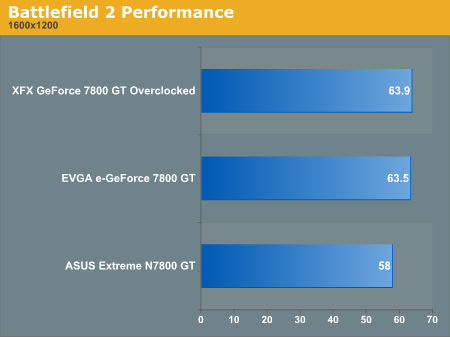
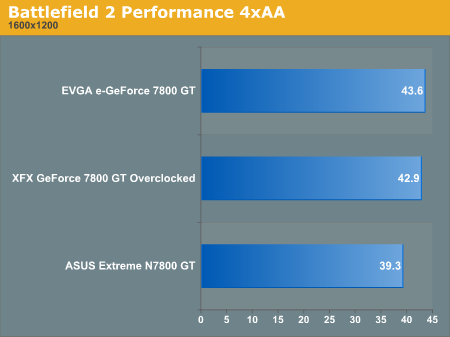

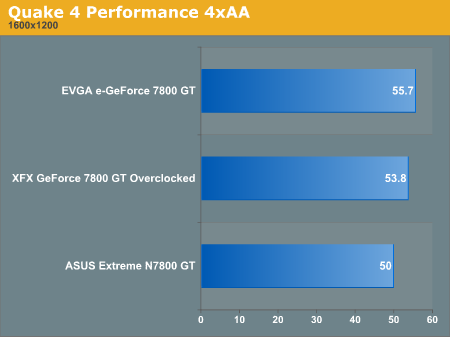
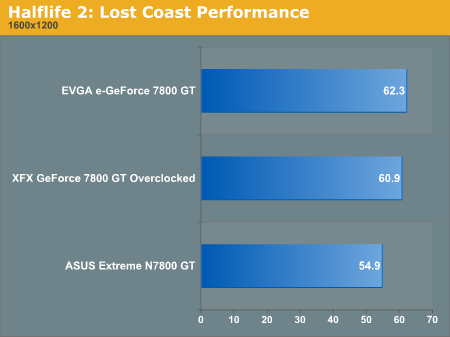
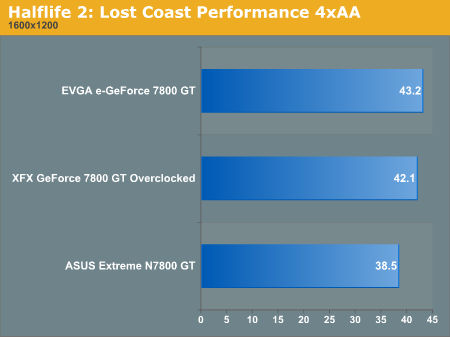
Essentially, what we see in these tests is that the difference in performance between a 7800 GT clocked at reference speeds and factory overclocked to 470MHz/1.1GHz or 450MHz/1.05GHz isn't enough to affect gameplay in a significant way. It's true that you can get a few fps higher in a game with an overclock like this, but it hardly ever makes it worth paying extra money for a card that's factory overclocked, especially when you can easily clock it yourself as high as or even higher than any other card out there. Interestingly though, in the case of these three 7800 GT's, the lowest clocked card (ASUS EN7800 GT) is also the highest priced, and the highest clocked card (EVGA e-GeForce 7800 GT) is the lowest price of the three.










33 Comments
View All Comments
ElFenix - Thursday, December 8, 2005 - link
i would like to know the volume and character of the fan noise as well please.Night201 - Thursday, December 8, 2005 - link
I have the XFX 7800 GT. I took this one over the other because it came with an additional game - Call of Duty 2 (free after you submit a rebate form - took only about 2 weeks!)It's the full DVD version and that right there saved me $50 - so the total cost of the card to me (since I was planning on getting COD2 anyway) was about $275!
Can't beat that (at this time at least)!
Visual - Thursday, December 8, 2005 - link
a roundup of cards that are virtually identical... oh how interesting.well. they aren't really identical. but i'd appreciate an article that shows me the differences more clearly, focuses on the differences. like which cards are using the stock cooler and which use custom ones, what are the memory ratings for the various brands etc... even what games/extras are included in each brand's package. a single good comparison table can speak much more than your numerous benchmarks. after all, benchmark results are just proportionate to the clock/mem speeds... the way you structured this roundup, i have to hunt around it for the real differences among these cards.
bob661 - Thursday, December 8, 2005 - link
I think this would be a good idea.ashegam - Thursday, December 8, 2005 - link
why isn't newegg showing on the Anandtech price finder? the e-vga can be had for $309 and that's before a $20.00 rebate which drops it to $289. So add newegg to your price engine thingy :)KristopherKubicki - Thursday, December 8, 2005 - link
You mean this one right?http://labs.anandtech.com/search.php?q=evga%207800...">http://labs.anandtech.com/search.php?q=evga%207800...
Kristopher
deathwalker - Thursday, December 8, 2005 - link
It is fully understandable that the EVGA and XFX cards get the nod in this test. I would be willing to bet that some owners of these cards will be frequent visitors to the AT forums complaining about "graphics" problems(artifacts/ripping tearing). Both of these cards come from the factory apparently OC so close to the max line the it is inconcievable that they are all going to behave themselves in the real world environment once volume numbers of these cards are in the hands of the buying public. You can bet that not every card that goes out the door at these clock speeds has been thoughly burned in to confirm they can actually run at these speeds for an "extended" duration of time. There are bound to be chipsets and memory modules in finished products that will not perform well at those clock speeds for extended periods. Perhaps the saving grace here though is that you can always lower the clock speeds back towards the referance points and probably fix the issues that "may" occur.deathwalker - Thursday, December 8, 2005 - link
Interesting that Newegg sells a version of this card that is clocked at 445/1070.Leper Messiah - Thursday, December 8, 2005 - link
Perhaps but stastically, the portion of cards sold vs. cards that have problems will be small (hopefully) and with their lifetime warranties, you can always send it back, ableit at the cost of your own shipping. C'est la vie I suppose. But I think christmas time is going to be bringing me a XFX 7800GT and some kind of NF4 mobo. :)deathwalker - Thursday, December 8, 2005 - link
Santa is going to be kind to you...have you been a "good" boy?